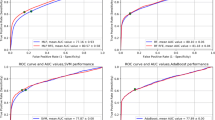Abstract
In this study we investigated whether automatic refinement of manually segmented MR breast lesions improves the discrimination of benign and malignant breast lesions. A constrained maximum a-posteriori scheme was employed to extract the most probable lesion for a user-provided coarse manual segmentation. Standard shape, texture and contrast enhancement features were derived from both the manual and the refined segmentations for 10 benign and 16 malignant lesions and their discrimination ability was compared. The refined segmentations were more consistent than the manual segmentations from a radiologist and a non-expert. The automatic refinement was robust to inaccuracies of the manual segmentation. Classification accuracy improved on average from 69% to 82% after segmentation refinement.
Chapter PDF
Similar content being viewed by others
Keywords
- Receiver Operating Characteristic
- Breast Lesion
- Magn Reson Image
- Manual Segmentation
- Malignant Breast Lesion
These keywords were added by machine and not by the authors. This process is experimental and the keywords may be updated as the learning algorithm improves.
References
Lucas-Quesada, F.A., et al.: Segmentation Strategies for Breast Tumors from Dynamic MR Images. J. Magn. Reson. Imaging 6, 753 (1996)
Jacobs, M.A., et al.: Benign and Malignant Breast Lesions: Diagnosis with Multiparametric MR Imaging. Radiology 229, 225 (2003)
Fischer, H., et al.: Local Elastic Matching and Pattern Recognition in MR Mammography. Int. J. Imaging Syst. Technol. 10, 199 (1999)
Brown, J., et al.: Magnetic Resonance Imaging Screening inWomen at Genetic Risk of Breast Cancer: Imaging and Analysis Protocol for the UK Multicentre Study. Magn. Reson. Imaging 18, 765 (2000)
Silverman, B.W.: Density Estimation for Statistics and Data Analysis. Chapman Hall, Boca Raton (1986)
Sinha, S., et al.: Multifeature Analysis of Gd-Enhanced MR Images of Breast Lesions. J. Magn. Reson. Imaging 7, 1016 (1998)
Gilhuijs, K.G.A., et al.: Computerized Analysis of Breast Lesions in Three Dimensions using Dynamic Magnetic-Resonance Imaging. Med. Phys. 1, 1647 (1998)
Sonoda, L. I.: Classification of Lesions in Magnetic Resonance Images of the Breast. PhD thesis, King’s College London (2003)
Metz, C.E., et al.: Maximum Likelihood Estimation of Receiver Operating Characteristics Curves from Continuously-Distributed Data. Statistics in Medicine 17, 1033 (1998)
Mussurakis, S., et al.: Primary Breast Abnormalities: Selective Pixel Sampling on Dynamic Gadolinium-Enhanced MR Images. Radiology 206, 465 (1998)
Liney, G.P., Gibbs, P., Hayes, C., Leach, M.O., Turnbull, L.W.: Dynamic Contrast- Enhanced MRI in the Differentiation of Breast Tumors: User-DefinedVersus Semi-automated Regions-of-Interest Analysis. J. Magn. Reson. Imaging 10, 945 (1999)
Author information
Authors and Affiliations
Editor information
Editors and Affiliations
Rights and permissions
Copyright information
© 2004 Springer-Verlag Berlin Heidelberg
About this paper
Cite this paper
Tanner, C., Khazen, M., Kessar, P., Leach, M.O., Hawkes, D.J. (2004). Classification Improvement by Segmentation Refinement: Application to Contrast-Enhanced MR-Mammography. In: Barillot, C., Haynor, D.R., Hellier, P. (eds) Medical Image Computing and Computer-Assisted Intervention – MICCAI 2004. MICCAI 2004. Lecture Notes in Computer Science, vol 3216. Springer, Berlin, Heidelberg. https://doi.org/10.1007/978-3-540-30135-6_23
Download citation
DOI: https://doi.org/10.1007/978-3-540-30135-6_23
Publisher Name: Springer, Berlin, Heidelberg
Print ISBN: 978-3-540-22976-6
Online ISBN: 978-3-540-30135-6
eBook Packages: Springer Book Archive




